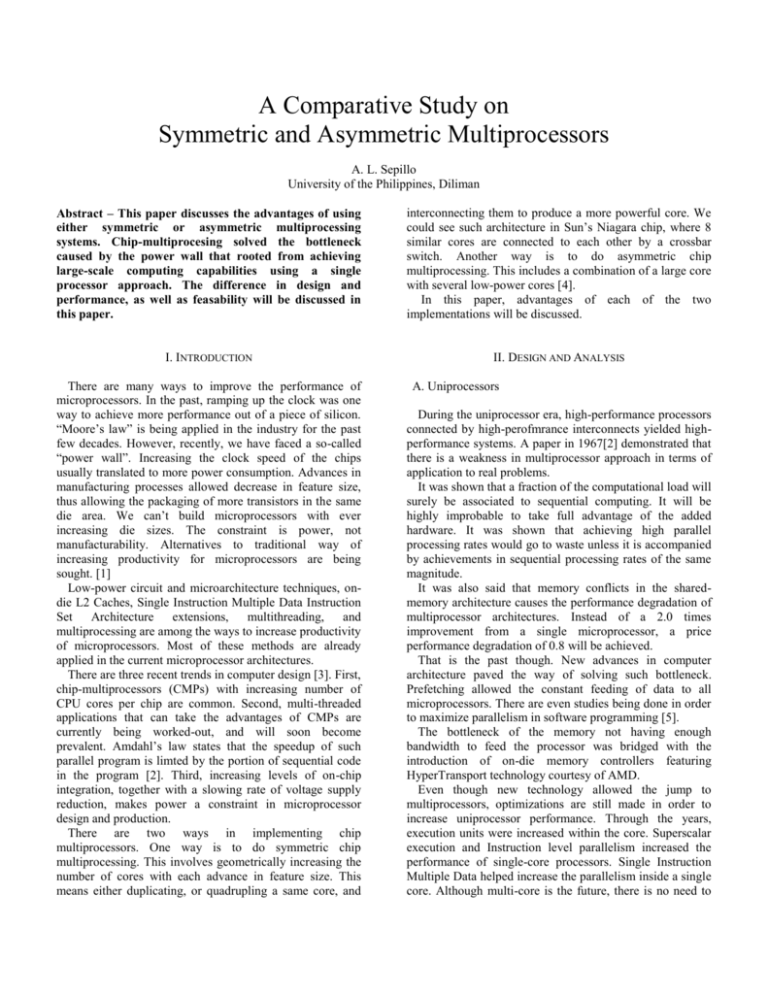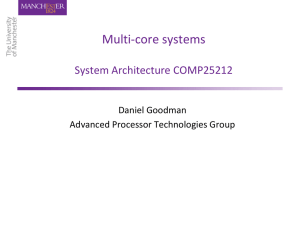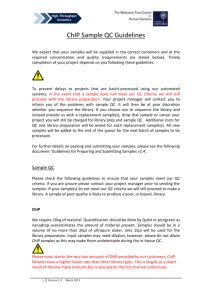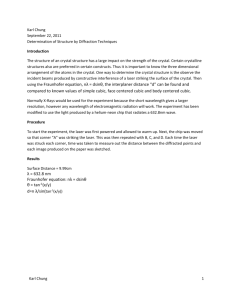A Comparison Between Single-Chip, Symmetric and Asymmetric
advertisement

A Comparative Study on Symmetric and Asymmetric Multiprocessors A. L. Sepillo University of the Philippines, Diliman Abstract – This paper discusses the advantages of using either symmetric or asymmetric multiprocessing systems. Chip-multiprocesing solved the bottleneck caused by the power wall that rooted from achieving large-scale computing capabilities using a single processor approach. The difference in design and performance, as well as feasability will be discussed in this paper. interconnecting them to produce a more powerful core. We could see such architecture in Sun’s Niagara chip, where 8 similar cores are connected to each other by a crossbar switch. Another way is to do asymmetric chip multiprocessing. This includes a combination of a large core with several low-power cores [4]. In this paper, advantages of each of the two implementations will be discussed. I. INTRODUCTION II. DESIGN AND ANALYSIS There are many ways to improve the performance of microprocessors. In the past, ramping up the clock was one way to achieve more performance out of a piece of silicon. “Moore’s law” is being applied in the industry for the past few decades. However, recently, we have faced a so-called “power wall”. Increasing the clock speed of the chips usually translated to more power consumption. Advances in manufacturing processes allowed decrease in feature size, thus allowing the packaging of more transistors in the same die area. We can’t build microprocessors with ever increasing die sizes. The constraint is power, not manufacturability. Alternatives to traditional way of increasing productivity for microprocessors are being sought. [1] Low-power circuit and microarchitecture techniques, ondie L2 Caches, Single Instruction Multiple Data Instruction Set Architecture extensions, multithreading, and multiprocessing are among the ways to increase productivity of microprocessors. Most of these methods are already applied in the current microprocessor architectures. There are three recent trends in computer design [3]. First, chip-multiprocessors (CMPs) with increasing number of CPU cores per chip are common. Second, multi-threaded applications that can take the advantages of CMPs are currently being worked-out, and will soon become prevalent. Amdahl’s law states that the speedup of such parallel program is limted by the portion of sequential code in the program [2]. Third, increasing levels of on-chip integration, together with a slowing rate of voltage supply reduction, makes power a constraint in microprocessor design and production. There are two ways in implementing chip multiprocessors. One way is to do symmetric chip multiprocessing. This involves geometrically increasing the number of cores with each advance in feature size. This means either duplicating, or quadrupling a same core, and A. Uniprocessors During the uniprocessor era, high-performance processors connected by high-perofmrance interconnects yielded highperformance systems. A paper in 1967[2] demonstrated that there is a weakness in multiprocessor approach in terms of application to real problems. It was shown that a fraction of the computational load will surely be associated to sequential computing. It will be highly improbable to take full advantage of the added hardware. It was shown that achieving high parallel processing rates would go to waste unless it is accompanied by achievements in sequential processing rates of the same magnitude. It was also said that memory conflicts in the sharedmemory architecture causes the performance degradation of multiprocessor architectures. Instead of a 2.0 times improvement from a single microprocessor, a price performance degradation of 0.8 will be achieved. That is the past though. New advances in computer architecture paved the way of solving such bottleneck. Prefetching allowed the constant feeding of data to all microprocessors. There are even studies being done in order to maximize parallelism in software programming [5]. The bottleneck of the memory not having enough bandwidth to feed the processor was bridged with the introduction of on-die memory controllers featuring HyperTransport technology courtesy of AMD. Even though new technology allowed the jump to multiprocessors, optimizations are still made in order to increase uniprocessor performance. Through the years, execution units were increased within the core. Superscalar execution and Instruction level parallelism increased the performance of single-core processors. Single Instruction Multiple Data helped increase the parallelism inside a single core. Although multi-core is the future, there is no need to fully jump to that bandwagon. Maybe many, but not all programs can take full advantage of the additional cores. Single processor systems will surely be eating a portion of the market even in the future. exhibit a leap in performance compared to single-processor counterparts in multithreaded applications. B. Symmetric Chip Multiprocessors In a chip microprocessor, no single core is ideal for the universe of applications existing. Heterogeneity of exploits such principle. Asymmetric Chip Multiprocessors, otherwise known as Heterogeneous Chip Multiprocessors, constitute both high and low-complexity cores. Many server applications focus primarily on throughput per cost and power. Desktop users are more interested in single applications or a few applications at the same time. A CMP for desktop users will likely be focused on smaller number of larger, yet powerful cores with better singlethread performance. Kumar et. al. believes that a heterogeneous microprocessors with both high and lowcomplexity cores is the best choice in core complexity [4]. Symmetric Chip Multiprocessors, as the name implies, involves connecting two or more similar cores into one die. An example of such chip is shown in Figure 1. CPU0 CPU1 CPU2 CPU3 C. Asymmetric Chip Multiprocessors Figure 1. A diagram of a Symmetric Chip Microprocessor Software applications contain two types of phases. There are serial and parallel types of phases. Serial phases can only be executed by on a single processor, while the other can be executed on more than one processor. A performance equation based on Amdahl’s law was shown in a paper by T. Morad, et. al[6]. It focused on achieving the highest performance of Symmetric Chip Multiprocessors. They came with an equation that implies that maximum performance for symmetric multiprocessors is achieved when the execution time of parallel and serial phases are equal. This agrees to the statement in the 1967 paper. The maximum performance as a function of total SCMP power is thus: PerfSCMP,max (P) = Perf (aopt(P)) 1/[2(1-)] (For the complete derivation of the performance equation, please see T. Morad, et. al.’s paper) Multiple processors running at a lower clock can equal the performance of a single processor running at a greater clock in terms of performance given the right applications. It will even consume less power than its single-processor counterpart. The concept of “slow but wide” is applied in multiprocessing. Commercial benchmarks show such improvements in terms of video encoding, computer-aided design, mathematical calculation, and server-based processing when utilizing multiple processors. Chip manufacturers today are currently embracing symmetric multiprocessor technology. Commercial desktop and server processors today utilize this computer architecture. Major names such as the Intel Xeon, AMD Opteron, Sun’s Niagara T1 follow the concept of these microprocessor architecture. These commercial processors Figure 2. A diagram of a Asymmetric Chip Multiprocessor Figure 2 shows a sample floorplan of an asymmetric chip multiprocessor. It constitutes of two high-performance cores, on the left side, four medium-performance cores on the lower right, and 9 simple cores on the upper right area. The concept of EPI is introduced in designing Asymmetric Chip Multiprocessors [6]. EPI stands for Energy per Instruction. As mentioned earlier, software applications contain serial phases as well as parallel phases. It was suggested that the lowest execution time for the serial phases is achieved by the highest performance single processor available, since the serial phases can be executed on one processor only. Parallel phases can be executed in numerous processors in parallel. The lowest and most optimal execution time for the parallel phases is achieved by executing such code on many simple processors that consume the least energy per instruction. The choice for symmetric cores is not as optimal as using asymmetric ones due to the difference in requirements of each of the serial and parallel phases within the same application. In the paper by Kumar et. al, they cited power and relative performance of Alpha cores scaled to 0.10m. It is shown in Table 1. Their respective performance is normalized with respect to the performance of the Alpha EV4 chip. The Alpha chip is a 64-bit RISC microprocessor designed for providing high-performance migration path for VAX customers. Even though this processor was phased out by HP, it still is a perfect example for the comparison for asymmetric multiprocessors in terms of power and performance. We could see that the EV4 chip consumes the least power of them all, as well as the lowest IPC (instructions per clock cycle). Its CPI translates to 1 clock cycles per instruction. Core Peak Power (Watts) Average Power (Watts) Performance (IPC) EV4 EV5 EV6 EV8 4.97 9.83 17.8 92.88 3.73 6.88 10.68 46.44 1.0 1.3 1.87 2.14 Table 1. Performance comparison of Alpha Cores Performance is normalized to EV4 performance. As the processor becomes more powerful and complex, its peak power and average power increases dramatically. Its IPC however is somewhat comparable to the simpler cores. It may achieve higher single-thread performance, it comes with a cost – loss of area and efficiency. Some applications require high ILP, this can be exploited with a core that can issue multiple instructions per cycle. The same core, however, might be very inefficient with applications with low ILP. A simpler core may be matched with the applications requirements. Using single-ISA heterogeneous CMPs could significantly reduce processor power dissipation. Power consumption and heat dissipation have become key challenges in high-performance processor designs. Recently, the industry had introduced techniques for power reduction. Clock gating and voltage/frequency scaling are used. These are very useful and effective when applied in single-core level. As for multiple cores, these techniques however suffer from limitations. Data must be passed onto different parts of the processor, and may be passed on unused portions that have been gated off, which consumes a substantial amount of power. Gating only reduces dynamic power. Large unused portions of the chip still consume leakage power. This is the same also with voltage/frequency scaling techniques. The ability to dynamically switch between different cores, and power down unused cores is the key in asymmetric chip multiprocessing. It was shown that a representative heterogeneous processor using two core types achieves as much as a 63 percent performance improvement over an equivalent-area homogenous processor [4]. Asymmetric multiprocessors achieve better coverage of a spectrum of load levels. As for Amdahl’s law, during the execution of the serial phases, the large core allows the serial phase to be executed as quickly as possible. For the parallel phases, the chip’s power budget is used more efficiently by running the parallel phase on smaller, area and power efficient cores. This maximizes the ratio of performance to power dissipation, as well as the performance per area metric. III. THE INDUSTRY In the past, the industry focused on ramping up the clock speed. During the 90’s, power was not yet a concern then, as chips would consume measly less than 20W. However, there came a time where performance was seemingly evaluated solely by the clock rate. The last try was the introduction of Intel’s Northwood and Prescott cores. Intel claimed that their chips can reach speeds up to 10GHz. Unfortunately, they hit the power wall, which halted performance, as well as their sales. Their counterpart, AMD, focused more on the parallelism of instructions, which in turn resulted into lower clock speeds, but made up for the performance it showed. The launch of the Intel Core Duo and Core 2 Duo became a big impact on the commercial microprocessor market. Its deviation from the classic “GHz” race to the “multi-core” race marked the entrance of a new era. The roadmaps of the microprocessor companies showed processors having quiad-cores, as well as eight cores on a single chip. As for server and workstations, symmetric multiprocessors are also applied. It can be seen on Sun’s Niagara chip. It features eight or six microprocessors on a single chip. They focused on executing more instructions per time. Asymmetric chip multiprocessors are yet to be featured commercially. They can only be seen on systemon-a-chip IC’s [6] . IV. FUTURE We have a bright future in multiprocessor performance. Optimizations are needed in order to get most out of the current advances in technology. In order to for the performance gain to be maximum, it was shown that the serial and parallel phase of a software programs must be equal. Large work is needed in order to have a jump in performance. It was stated in the paper “Limits on ILP” that the benefits will be depended on how much work is done in order to do parallelism. I think this is also applicable in creating multiple threads for multiple processors. Also, it was stated that designing a chip multiprocessor is a systemlevel optimization problem. Some architectural beliefs do not hold when interconnection overheads are properly accounted for. An example would be shared caches are not as desirable compared to private caches if the cost of the crossbar is carefully factored in. The future lies in the careful and intelligent design of Asymmetric Chip Multiprocessors. The advantages of Asymmetric Chip Multiprocessors clearly outweigh that of Symmetric Chip Multiprocessors. It will just take a matter of time before we jump to the new bandwagon, just like the jump from uniprocessor to multiprocessors. Who knows, we term “transistor count” previously used to measure the microprocessors will become “processor count”. REFERENCES [1] [2] [3] [4] [5] [6] [7] [8] F. Pollack. “New Microarchitecture Challenges in the Coming Generations of CMOS Process Technologies.” In Micro 32, 1999. http://intel.com/research/mrl/Library/micro32Keynote.pdf G. Amdahl. “Validity of the single processor approach to achieveing large scale computing capability.” In Proc. AFIPS Spring Joint Computer Conf., 1967, pp 483-485. M. Annavaram, E. Grochowski, and J. Shen. Mitigating Amdahl’s Law through EPI throttling. In 32nd Annual International Symposium on Computer Architecture (ISCA ’05), pages 2980398, June 2005. R. Kumar, D. Tullsen, N. Jouppi, R. Ranganathan. “Heterogeneous Chip Multiprocessors” Computer. Volume 38, Issue 11, pages 32-38, Nov. 2005. Hochstein et al. “Parallel Programming Productivity: A Case Study of Novice Parallel Programmers” Proceedings of the 2005 ACM/IEEE conference on Supercomputing SC ’05 T. Morad, U. Weiser, A. Kolodny, M. Valero, E. Ayguade. “Performance, Power Efficiency and Scalability of Asymmetric Cluster Chip Multirprocessors”, IEEE Computer Architecture Letters, Vol 5, 2006 D. Wall, “Limits of Instruction Level Parallelism”, WRL Research Report 93, Nov. 1993 R. Grant, A. Afsahi. “Power-Performance Efficiency of Asymmetric Multiprocessors for Multi-threaded Scientific Applications”, IEEE Journal, 2006








